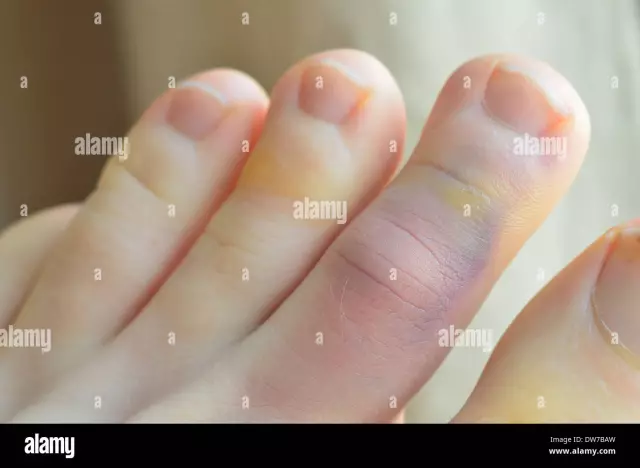- Author Rachel Wainwright [email protected].
- Public 2023-12-15 07:39.
- Last modified 2025-11-02 20:14.
Patella
Patella structure
The patella is the largest sesamoid bone in the human skeleton. It is located in the thickness of the quadriceps-thigh, is well palpable through the skin, easily displaced when the knee is extended. The upper edge of the patella is rounded, called the base of the patella. The top of the patella (its lower edge) has a slightly elongated shape. The anterior surface of this bone is rough, it contains holes for blood vessels, and the place of attachment of the rectus femoris tendon is also located. On the posterior (articular) surface of the patella, two unequal parts are distinguished, bounded by a vertically located ridge: the smaller is the medial part, the larger is the lateral. These areas are covered with articular cartilage. The lateral articular surface articulates with the outer condyle of the thigh, the medial one with the inner condyle. A little more medially is the area, with full extension of the knee in contact with the inner condyle of the femur. The thick layer of articular cartilage significantly improves the congruence of the contacting surfaces, and also reduces the compression loads on the knee joint. In newborns, the patella has a cartilaginous structure. The center of patellar ossification appears at about 2-4 years.

The patella is the center of rotation. It ensures the efficiency of the quadriceps femoris muscle while transferring the load to the knee joint area. The load on the patella is very complex and consists of both tension and compression with minimal friction. The structure of a given bone reflects the ratio of forces constantly acting on it.
Patella ligament
The patellar ligament originates from the apex of the patella and attaches to the tibial tuberosity. It distributes the tensile loads affecting the knee joint. The fibers of this ligament start quite far apart in the region of the posterior and inferior surfaces of the patella. Near the place of attachment, fibers of the tendon of the rectus femoris also join them. 85% of the dry matter of the patellar ligament is collagen.
Patella displacement
The patella connects the muscles of the lower leg and the front of the thigh. Normally, it is held tightly in place. In case of violations of the structure of the patellar surface (flattening, roughness), this bone can slip off it, and the patella is displaced: subluxation or dislocation.
Patellar dislocation
Dislocation of the patella is a variant of its instability. Dislocation of the patella can be caused by many factors, but in the pathogenesis there is always a stretching of the external ligament that supports the patella, as well as muscle atrophy and an abnormal shape of the legs (X-shaped curvature, hyperextension). The main signs of such displacement of the patella are pain and a feeling of instability in the front of the knee joint, a history of trauma (damage to the knee joint) or surgery on the knee joint with mobilization of the outer edge of the patella. On the roentgenogram with this pathology, characteristic signs of patellar dislocation are found. Treatment is usually conservative, which consists in stabilizing the patella. For this purpose, orthopedic devices or bandages are used. If symptoms persist,that disrupt the function of the limb, surgical intervention is necessary.
Patella fracture
Fractured patella is a common injury. It usually occurs when you fall on a bent knee. Less commonly, a patellar fracture occurs with a direct impact on a given bone, extremely rarely - with a strong tendon traction. Symptoms of such an injury are pain, aggravated by movement of the lower limb, swelling, inability to straighten, as well as raise a straightened leg, deformity. Treatment of a patellar fracture depends on the nature of the fracture itself, as well as the presence of displacement of the fragments. Conservative treatment is possible with stable fractures without displacement. In other cases, surgery is required.
Found a mistake in the text? Select it and press Ctrl + Enter.






